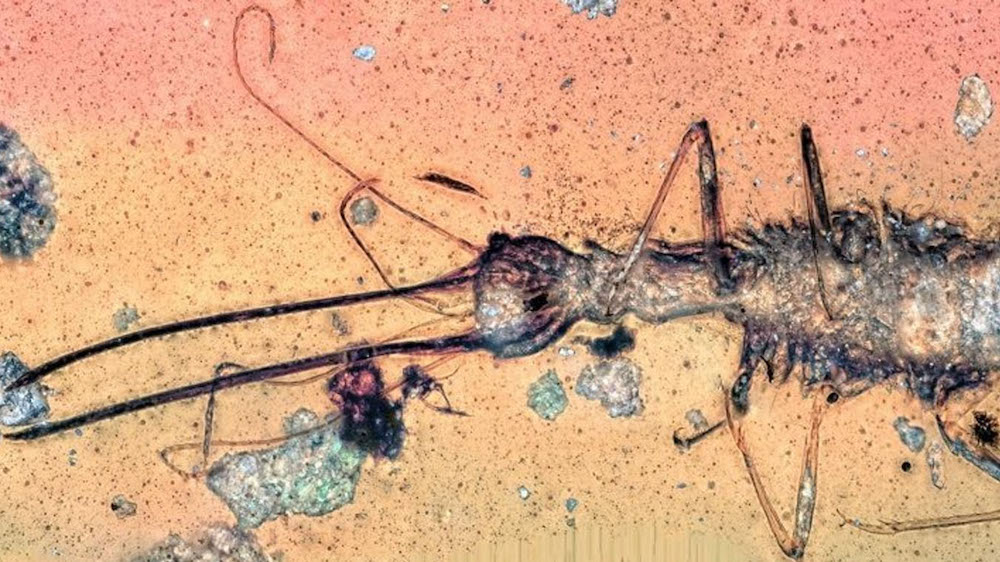Create a free profile to get unlimited access to exclusive videos, sweepstakes, and more!
Extreme bugs from 100 million years ago were super-predators that knew how to survive
Prehistoric lacewing larvae evolved grotesque bodies and gnarly, venom-injecting mouthparts.

When you think of extreme creatures from the Cretaceous Period, dinosaurs probably come to mind, but other strange life-forms were crawling around.
Holometabolans are insects that go through metamorphic transformations in each phase of life until they reach adulthood. They range from beetles to butterflies, and their larval forms usually look like grubs or caterpillars without much to show off — except maybe poisonous spines — but one of the weirdest holometabolan larvae has to be that of a now-extinct species of lacewing that lived during the Early Cretaceous. That it goes against the stereotype is an understatement.
Paleobiologist Joachim Haug, of the University of Munich in Germany, and his research team made what was both a nightmarish and fascinating discovery. Prehistoric lacewing larvae trapped in Burmese amber had much more bizarre forms than what would have been expected of a holometabolan. Haug led a study recently published in Scientific Reports.
“The differentiation between adult and larval morphology reflects a strong differentiation in ecological roles between the two,” Haug told SYFY WIRE. “This reduces competition between the two, as larvae can exploit quite different resources and circumvent limitations of resources in this way.”
The bodies of these larvae were anything but featureless. They were grossly elongated, almost as if they had been purposely distorted for a horror movie, and had legs, more like the larvae of predatory beetles than butterflies. Extant lacewing larvae have protruding mouthparts known as stylets. They kill by injecting their prey with venom, but their ancestors took it to a whole other level with stylets that were much longer than hose of their existing brethren, and mostly straight instead of curved. The ends of these were armed with structures similar to teeth.
It is thought that these mouthparts were useful for injecting prey with venom from a distance. That way, the prey would not be able to approach close enough to attack the predator, though what this extinct lacewing species even hunted remains a mystery. Haug believes that the ferocious stylets were probably filling a functional need, because Cretaceous lacewing larvae must have had a specialized ecological role that remains unknown. They may have had a taste for something that bit back if they evolved such ferocious weapons near its mouth.
Larvae that had needs so different from adults may have led to the success of holometabolans, but evolution can bring on the unexpected. There could be a reason they didn’t need such huge mouthparts or elongated features anymore. Maybe lacewings ended up finding easier prey, or easier ways to get around meant their bodies didn’t need to be so extreme. Like some of their more impressive features of lacewing larvae downgraded from R-rated horror to something more PG, there are other holometabolan species that seem to have evolved backwards.
"There seems to be a general selection towards metamorphosis,” Haug said. “Still, under specific conditions, there is also a loss, or at least a reduction, of this differentiation that has evolved. Within holometabolans, this happened to some beetles, like fireflies.”
Some groups of holometabolans have declined in diversity altogether, and lacewings are one of them. The reason they diversified so much to begin with is most likely the way they co-evolved with flowering plants. So maybe these killer larvae were after something else that was attracted to nectar. None of these extreme morphologies are seen in extant lacewing larvae. Though they still have mouthparts for piercing and sucking, it is highly unlikely that the larva of a green lacewing (which the extinct species could be related to) would be nightmare fuel.
“Other lineages seem to have strongly diversified later, and may have partly substituted for some of the ecological functions originally fulfilled by lacewings,” Haug said. “We want to identify more possible causes and other mechanisms of diversification and extinction.”
At least this tiny monster being extinct means you won’t have to sleep with the light on.




























